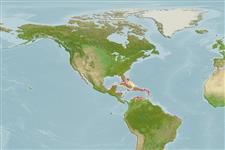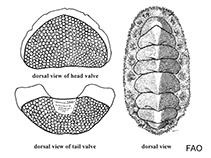Acanthochitona spiculosa Reeve, 1847
Glass-haired chiton| Native range | All suitable habitat | Point map | Year 2050 |

|
| This map was computer-generated and has not yet been reviewed. |
| Acanthochitona spiculosa AquaMaps Data sources: GBIF OBIS |
Upload your photos
Google image | No image available for this species;
drawing shows typical species in Acanthochitonidae.
Google image | No image available for this species;
drawing shows typical species in Acanthochitonidae.
Classification / Names Common names | Synonyms | CoL | ITIS | WoRMS
Polyplacophora | Chitonida | Acanthochitonidae
Environment: milieu / climate zone / depth range / distribution range Ecology
Benthic; depth range 0 - 2 m (Ref. 2022). Tropical
Distribution Countries | FAO areas | Ecosystems | Occurrences | Introductions
Western Central Atlantic: USA, Colombia and the West Indies.
Length at first maturity / Size / Weight / Age
Maturity: Lm ? range ? - ? cm Max length : 3.8 cm TL male/unsexed; (Ref. 281)
Short description Morphology
Maximum Total Length: 3.8 centimeters. Body: Elongated; has girdle that covers most of the valves. Valves: Have four clumps of long, glassy bristles near the anterior valve and one on each side of the other valves. Clumps: Set in cuplike collars of the girdle. Pustules: Tiny, round, sharply raised; covering end valves and lateral areas of middle valves. Dorsal longitudinal ridge: Raised, narrow, distinct and smoothish except for very fine pinpoints. Lower edge of the girdle: Dense fringe of brown or bluish bristles (Ref. 281).
Life cycle and mating behavior Maturity | Reproduction | Spawning | Eggs | Fecundity | Larvae
Members of the class Polyplacophora are mostly gonochoric. Life cycle: Eggs hatch into lecitotrophic planktonic trocophore larvae (no veliger stage) which later metamorphose and settle on the bottom as young adults.
Main reference
References | Coordinator | Collaborators
Burghardt, G. and L. Burghardt. 2006. (Ref. 281)
IUCN Red List Status (Ref. 130435)
CITES status (Ref. 108899)
Not Evaluated
CMS (Ref. 116361)
Not Evaluated
Threat to humans
Human uses
| FishSource |
Tools
More information
Internet sources
BHL | BOLD Systems | CISTI | DiscoverLife | FAO(Publication : search) | Fishipedia | GenBank (genome, nucleotide) | GloBI | Gomexsi | Google Books | Google Scholar | Google | PubMed | Tree of Life | Wikipedia (Go, Search) | Zoological Record
Estimates based on models
Preferred temperature
(Ref. 115969): 23.8 - 28.3, mean 27.1 (based on 319 cells).
Price category
(Ref. 80766):
Unknown.



